Pruning trees and shrubs is perhaps the least understood and most abused of all gardening chores. Many people prune their plants for the same reason some climb mountains…because they’re there. They head outdoors with loppers and a saw in hand with little knowledge of the plant’s ideal form, the best time to prune, the proper way to make a pruning cut…or, when to stop. Incorrect pruning results in poor growth, unnatural plant forms, and poor flower and fruit production.
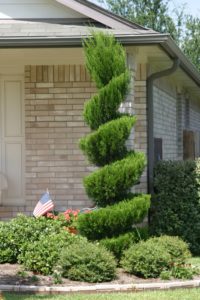
Topiary pruning is labor intensive to maintain
For some reason crape myrtles are singled out like no other as the target of amateur attempts at pruning each winter season. It is almost a ritual about town. However, word is finally beginning to get out about crape myrtles and how not to prune a crape. But what about other plants?
Why Prune?
When we prune a plant we should have a specific purpose in mind. Some good reasons for pruning include shaping plants, removing dead and damaged branches, and containing plants which are outgrowing their area. Shade trees are sometimes pruned to raise the lower canopy or to correct a poor structure.
Plants may be pruned to improve flower production – roses and crape myrtles being examples. Fruit trees are pruned to increase new growth and fruit formation. Pruning an old plant can help rejuvenate it and encourage new growth.
Pruning has its primary place in training a new tree, shrub or vine. When this is done properly it eliminates virtually all pruning later in the life of most trees, and many shrubs. In fact, in most cases if you are using a saw on a landscape plant it is usually an indication that a poor job of training was done early in the life of the plant.
When To Prune?
Late winter, just before the emergence of new spring growth, is the best pruning time for many plants in the home landscape. This is especially true of deciduous trees and even most evergreens. The primary exceptions are ornamental plants that bloom in spring. Winter pruning removes bloom buds and therefore limits the blooming show. These are better left until after they bloom before pruning them. This chart shows the best times to prune various types of woody ornamentals.
Fruit trees do indeed bloom in spring, but they are grown for crops and not just the beauty of blooms. Pruning is done to manage crop load and to increase light penetration into the tree, as well as to remove diseased and insect infested wood. We won’t go any further into the subject of fruit tree and vine pruning here. For more information on proper pruning of various types of fruit trees check out the information guides at https://aggie-horticulture.tamu.edu/fruit-nut/
Berrying ornamentals such as hollies and pyracantha produce berries on old or second-year growth. A continual removal of a large percentage of the new growth on these plants eliminates potential berries.
Stop Most Pruning in August
Minor pruning of woody ornamentals to correct and train the plants can be done at most times of the year. Plants may need a bit of light touch up work throughout the season. Gangly canes or shoots may be trimmed back whenever they appear to maintain a plant’s form.
It is generally best to stop trimming plants by about August in order to avoid encouraging a late season flush of growth which would be prone to cold injury from an early freeze.
One additional note about the pruning time is in reference to oak wilt; a devastating disease of oak trees that is especially prevalent in central Texas but has reached other areas of the state as well. The beetle that spreads oak wilt and the infectious fungal mats on which the beetles feed are most active in spring but may be active in most months of the year. If you prune oaks when beetles and fungal mat infections are active you are inviting these disease carrying beetles to come and infect your tree.
Thus pruning of oaks is best kept to the coldest months or if absolutely necessary, the hottest months in order to avoid inviting trouble. It is also important to paint pruning cuts on oak immediately (not hours later) with a commercial pruning sealant or latex paint to repel the beetles.
How to Prune Shrubs
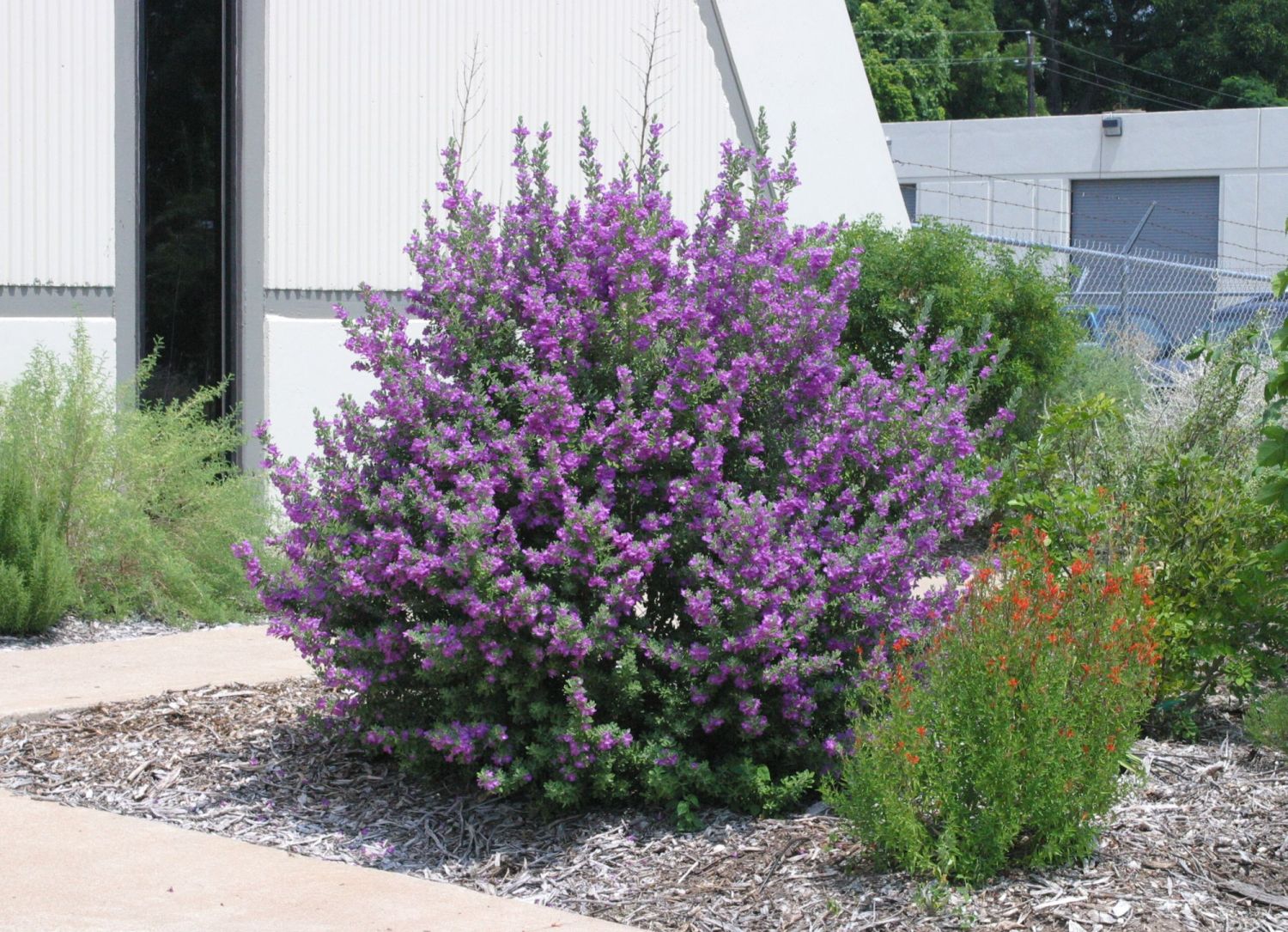
Cenizo with a natural pruning form
Try to keep natural forms
The gardener looking for low maintenance should not establish a clipped or formal hedge, but instead direct growth in a more natural form. Sheared hedges require more regular shearing to keep their desired shape and can make the yard look unkempt if not diligently maintained.
Avoid top-heavy hedges
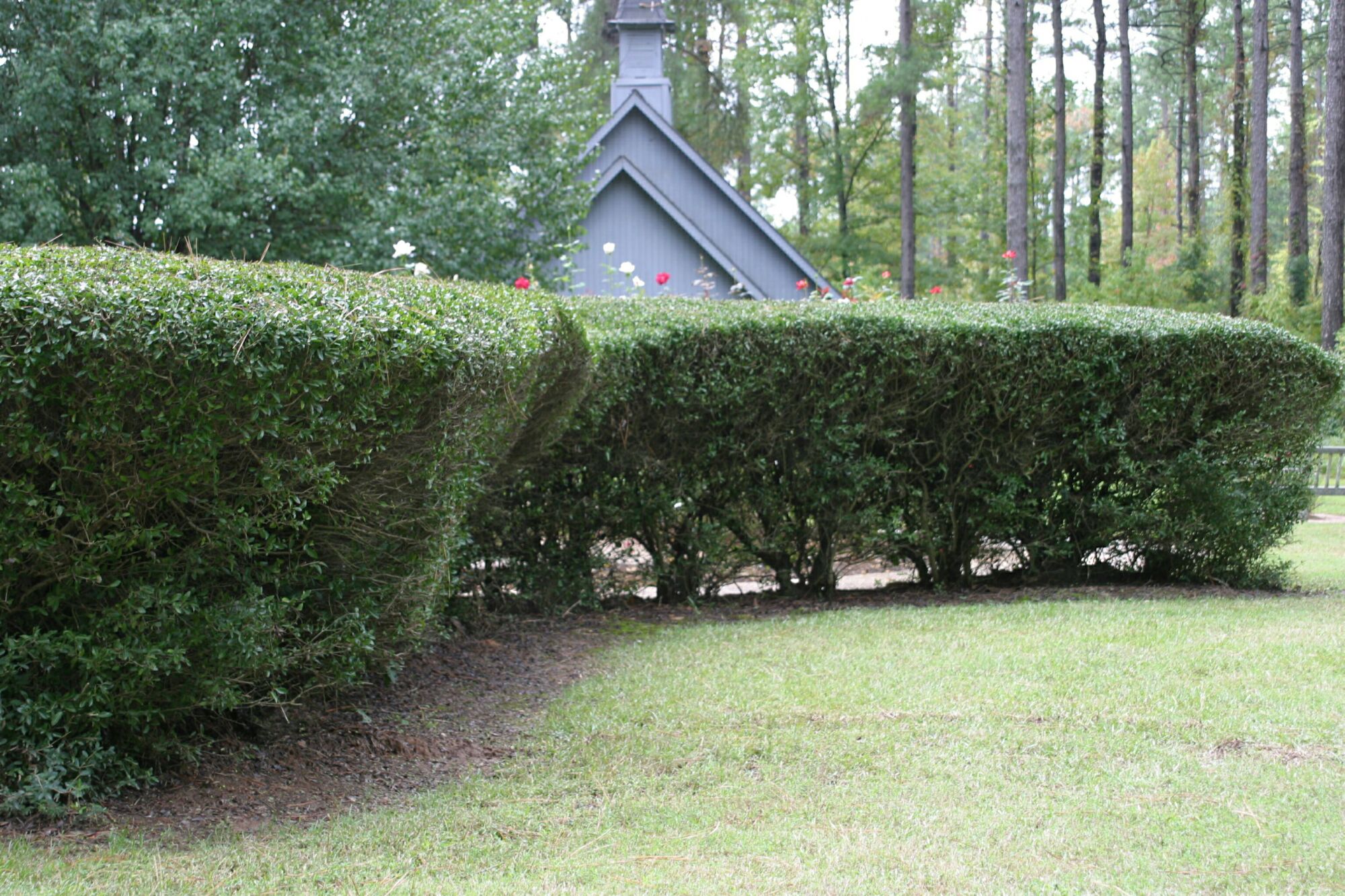
Yaupon hedge trimmed top-heavy and losing lower foliage density
Hedges should be wider at the base than at their top. This is to promote good foliage cover and density all the way from the top to bottom. They are forever attempting to grow top heavy which shades the base.
Use thinning cuts
Informally trained evergreens can be kept in bounds by moderate pruning using thinning cuts. Unlike hedges which are pruned all to the same plane by shearing, thinning cuts selectively remove shoots by cutting them back to where a side shoot is attached. With such pruning, when you are done the plant although smaller and more balanced does not really look like it was just pruned, but rather has a graceful natural look.
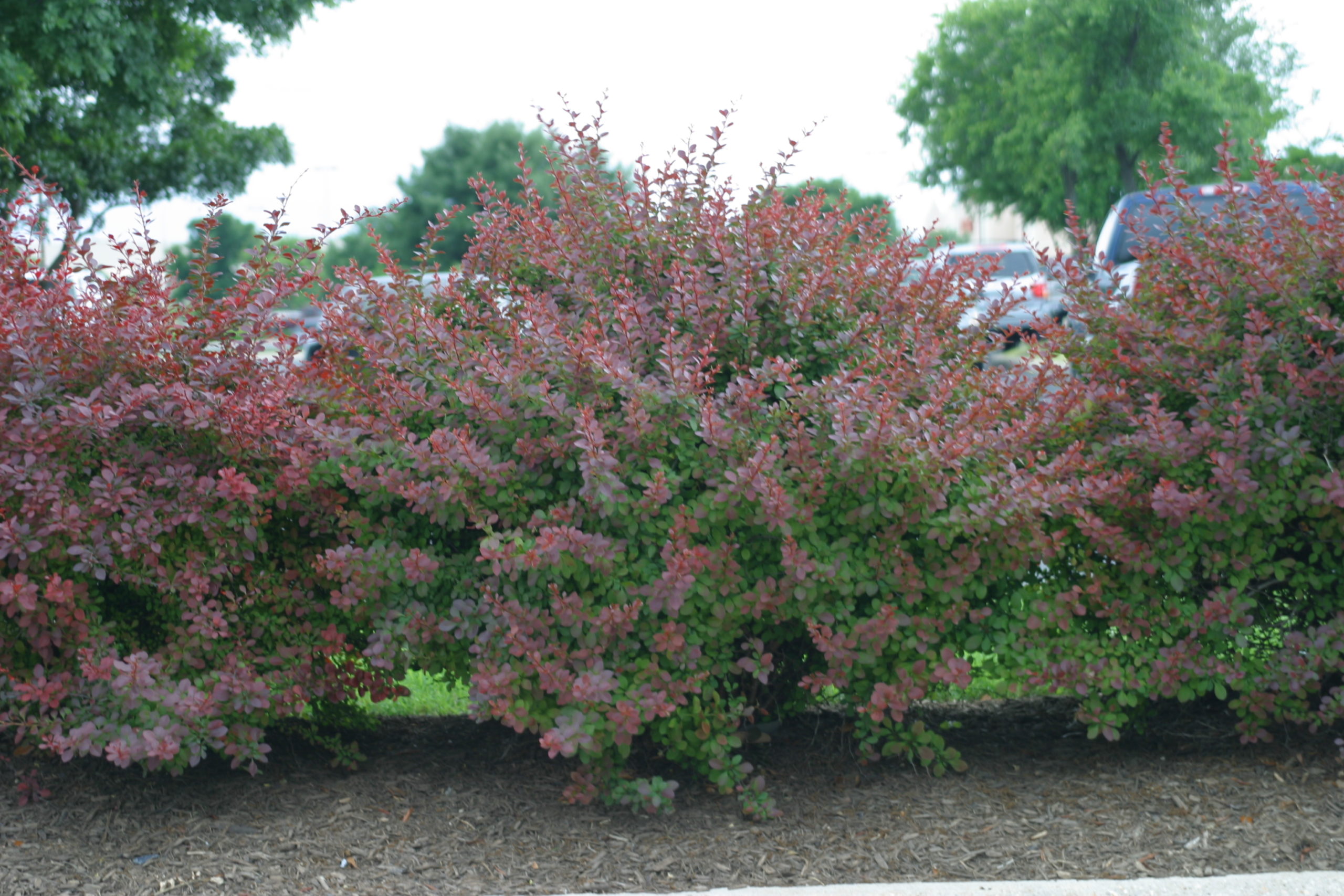
Barbary shrub informally trained
Deciduous shrubs may be pruned in much the same manner. In addition to thinning cuts, some plants that tend to produce multiple stems will benefit from having a few of the older shoots removed at the base. This slowly rejuvenates the shrub over time. Nandinas are a good example of a shrub suited to this type of pruning.
How to Prune Trees
The earlier you start careful training of your tree, the less major problems you will likely encounter later. Careful training with a plan in mind will turn a spindly new transplant into a strong, beautiful shade tree in time.
For best results, always begin with the end in mind. Those tiny branches are envisioned as large scaffold limbs on a shade tree. Some must go and others will stay. Twin trunks cannot be allowed to grow on together. As hard as it is to cut one or the other out, it will be even more difficult later and the tree will be the worse for it. Put it off long enough and a strong wind or ice storm will make the decision for you. Small cuts made with a hand pruner or even loppers when the tree is young will heal much faster than would the same branch removed years later with a saw.
Wide angled branches are stronger that narrow angled ones. Thus narrow “V” shaped branches are removed along with crossing or rubbing branches. Don’t strip off all the small shoots along the trunk or main branches. Leave them to grow until they reach about an inch in diameter and then remove those that are not part of the future structural limbs of the tree. By leaving them, these “nurse limbs” will grow leaves that produce carbohydrates to nourish the tree and help build and support an extensive root system during the early years. They’ll give the tree a boost and get you to a nice sized shade tree in less time.
A Proper Pruning Cut
Proper cuts heal rapidly. Make cuts just outside the natural “collar” where the branch to be removed attaches to the trunk or a larger limb. Don’t leave a stub, which only invites decay into the tree, and don’t cut them back flush against the trunk. This only makes for a larger wound and removes the important collar tissues which promote speedy healing.
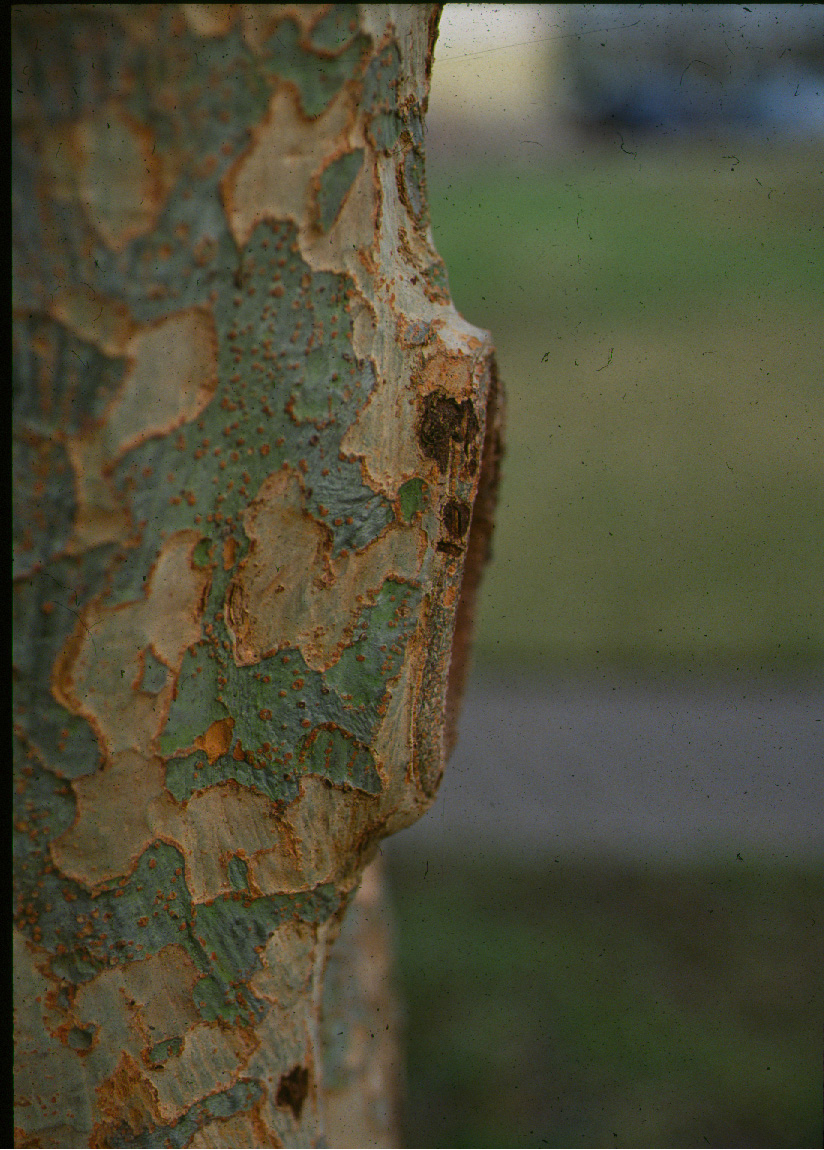
A proper pruning cut leaves the branch collar
Use the 3-cut method when you do need to remove a large limb to prevent it from stripping the bark down the trunk. Start by cutting upward from beneath the branch, cutting about 1/3 of the way through. Then cut downward from above and farther out to remove the branch. Finally remove the remaining stub with a cut just outside the natural branch collar.
Wound sealer products are not necessary, with the exception of deterring oak wilt, and then only if applied immediately. These pruning paints may be of some benefit if used properly and maintained through follow up applications. However, no one really ends up doing that and cracks in the sealed surfaces then form which allow water through, slow drying of the interior wood and promote decay. Therefore their use is discouraged.
Proper pruning can help train a new tree or shrub into a great asset to your landscape. It can enhance the beauty of plants and keep them in bounds and in balance. Do a little studying up before heading out with saw in hand this winter. There is plenty of good information out there to guide you in pruning most any type of plant. Prune with a clear purpose and plan in mind.
Pruning Quick Reference Chart
Jan/Feb
|
April/May/June
|
|
Shade Trees Summer Flowering Trees |
Winter/Spring Flowering Trees
|
|
Summer Flowering Shrubs
|
Winter/Spring Flowering Shrubs |
|
Broadleaf and Needleleaf Evergreens
*These produce attractive berries on previous year’s growth. Trim lightly in spring to remove out of bounds shoots and (if needed) again in summer taking care not to remove bloom clusters or small fruits. Please note that in order to prevent the spread of oak wilt, oaks should not be pruned between February 1 and June 30, and all wounds should be painted any time of year. |
|
Additional Pruning Resources
Earth-Kind® Landscaping Follow Proper Pruning Techniques
Aggie Hort Fruit Nut Resources (individual pdfs on how to prune each type of fruit)
Pruning Guidelines for Oak Wilt Prevention

